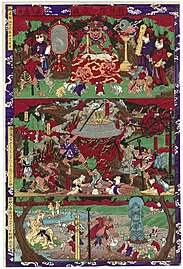Omocha-e (Japanese: 玩具絵, "toy prints") is a genre of Japanese woodblock prints ukiyo-e created as picture books and toys for children. The genre was considered inferior to prints of kabuki actors (yakusha-e) or prints with beautiful women (bijin-ga).
There were many types of Omocha-e, including paper dolls to be dressed (kisekae-e), matching-picture games (e-awase), board games (such as sugoroku), dioramas to be cut out and assembled (tatebanko or kumitate-e), and encyclopedic compilations (monozukushi).
- Omocha-e by Utagawa Yoshifuji
-
 Omocha-e with horses
Omocha-e with horses
-
 Omocha-e from the picture album "Sugoroku"
Omocha-e from the picture album "Sugoroku"
-
 Omocha-e with cats and women from the picture album "Sugoroku"
Omocha-e with cats and women from the picture album "Sugoroku"
-
 New Patterns for Summer Costumes
New Patterns for Summer Costumes
-
 New Print of Hoko Float to Assemble
New Print of Hoko Float to Assemble
-
 Newly Published Comic Picture of Cats
Newly Published Comic Picture of Cats
-
 Cats in backstage at Kabuki theater
Cats in backstage at Kabuki theater
References
- "The World of Omocha-e : Opinion : Chuo Online". yab.yomiuri.co.jp. Retrieved 20 August 2023.
- Chen, Minjie (2 February 2018). "Before Pokémon and Yo-kai Watch: A Window onto One of the Earliest Unique Forms of Japanese Animé at the Cotsen Children's Library". Cotsen Children’s Library. Retrieved 20 August 2023.
- Tara M. McGowan (2013). "The Designs of Kawasaki Kyosen: Envisioning the Future of a Vanishing World through Toy Pictures (Omocha-e)". The Princeton University Library Chronicle. 74 (3): 320. doi:10.25290/prinunivlibrchro.74.3.0320.
External links
 Media related to Omocha-e at Wikimedia Commons
Media related to Omocha-e at Wikimedia Commons
| Ukiyo-e | ||
|---|---|---|
| General |  | |
| Themes |
| |
| Region specific themes | ||
| Techniques | ||
| Schools | ||
| Related traditions | ||